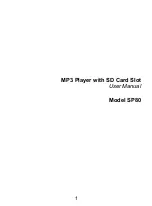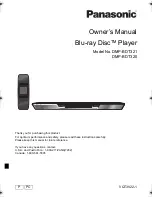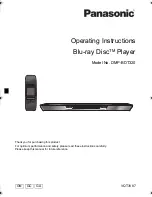
General Information
Section 1
January 2009
Digital Talking-Book Player
11
Library Guide
1.4.1.2
Navigation Control File
The Navigation Control file (NCX) exposes the hierarchical structure of a DTB to allow the user to navigate through
it. The NCX is similar to a table of contents in that it enables the reader to jump directly to any of the major structural
elements of the document, i.e., part, chapter, or section. However, it will often contain more elements of the
document than the publisher chooses to include in the original print table of contents. Other elements such as pages
can be included in separate, nonhierarchical lists and can be accessed by the user as well. These NCX elements
contain pointers to elements in the SMIL file. Each NCX element has an associated audio label (or tag) that the player
renders to notify the user (e.g., “Chapter One”). These labels access clips in audio files directly, not through the
SMIL files.
It is important to emphasize that these navigation features are intended as a convenience for users who want them,
and not as a burden to those who do not. The NCX is used primarily by the Advanced Model. It does not contain
information required for linear playback of the book.
1.4.1.3 SMIL
Files
The SMIL (Synchronized Multimedia Integration Language)
files contain information that weaves together the
various parts of the audiobook into a complete presentation. These files define the order, timing, and location of the
audio clips that compose the DTB. There will be one or more SMIL files in each DTB. Each SMIL element will
identify an audio file that contains the clip. The start and end times of the clips referenced in the SMIL elements are
relative to the audio file and not the entire DTB.
1.4.1.4 Audio
Files
The digitized audio files are compressed during the production of the DTB to reduce their size. NLS uses AMR-
Wideband Plus (WB+), an advanced compression standard specifically designed for high-quality voice compression.
The compressed audio is stored on the cartridge in the 3GP file format.
1.4.1.5
Authorization Object File
The audio files and the content of some other files are encrypted to meet the requirements of copyright law. The keys
to decrypt the audio and markup files are unique for each book and are themselves encrypted and stored in the
Authorization Object file. The player contains a private key that is used to decrypt the Authorization Object file and
recover the book keys required to decrypt the book content. Commercial players that have not been enabled to play
NLS books do not contain this key and thus are unable to play NLS protected books.
1.4.1.6 Administrative
Files
A DTB contains several files that play no role in rendering the book. These files describe the rules that the book
content must follow to be valid. They are used in the production and validation of the DTB.
1.4.1.7 Façade
Book
All NLS DTBs actually have a second book contained on the cartridge. This so called Façade Book is played only
when the encrypted book cannot be played. A Façade Book will never be heard when playing a book on an NLS
player, but it may be played on a third party commercial player that has not been authorized to play NLS books. The
Façade Book merely informs users that they are not authorized to read the book.
1.4.2 How the Player Uses the Files
To read a book linearly, that is to say from beginning to end, the player opens the
Package File
and uses the “spine”
to identify the sequence of one or more
SMIL file
presentations to play. The
SMIL file
contains a series of pointers
to audio clips to be played. These clips are located in the compressed
3GP Audio Files
.
If a user wishes to use the features of the Advanced Model to move directly to a place in hierarchical book structure,
such as a chapter, the player will use the information contained in the
NCX file
that will point to the position in a













































